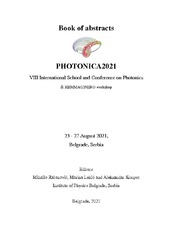Приказ основних података о документу
Label-free third harmonic generation imaging of lipid droplets in live filamentous fungi
| dc.contributor | Rabasović, Mihailo D. | |
| dc.contributor | Lekić, Marina | |
| dc.contributor | Krmpot, Aleksandar J. | |
| dc.creator | Pajić, Tanja | |
| dc.creator | Todorović, Nataša | |
| dc.creator | Živić, Miroslav | |
| dc.creator | Rabasović, Mihailo D. | |
| dc.creator | Clayton, Andrew H. A. | |
| dc.creator | Krmpot, Aleksandar J. | |
| dc.date.accessioned | 2022-01-17T13:47:19Z | |
| dc.date.available | 2022-01-17T13:47:19Z | |
| dc.date.issued | 2021 | |
| dc.identifier.isbn | 978-86-82441-53-3 | |
| dc.identifier.uri | http://radar.ibiss.bg.ac.rs/handle/123456789/4712 | |
| dc.description.abstract | Oleaginous fungi can accumulate significant amounts of lipids in their mycelium (up to 80% of their biomass), primarily in the form of lipid droplets (LDs). LDs have optical properties that differ from the surrounding aquatic environment, which causes sudden changes in the refractive index. Here, we present in vivo and label-free imaging of individual hyphae of the oleaginous filamentous fungus Phycomyces blakesleeanus by Third Harmonic Generation (THG) microscopy method, where LDs are the main source of contrast. The LDs quantification from THG images was performed by two image analysis techniques: Image Correlation Spectroscopy (ICS) and software particle counting – Particle Size Analysis (PSA). ICS measures the spatial variation of fluorescence intensity fluctuations in the images, which can then be related to particle density and aggregation state. In order to test and compare the two methods, we used hyphae that undergo nitrogen starvation, which is known to cause alterations in lipid metabolism and the increase in LDs number. For in vivo THG imaging of label-free, > 24-hour old hyphae, we used 1040 nm, 200 fs pulses from Yb KGW laser. Detection was performed in the transmission arm by PMT through Hoya glass UV filter with peak transmission at 340nm. The laser beam was focused with the Zeiss Plan Neofluar 40x1.3 objective lens. For the imaging, the fungi were placed between two cover glasses of 0.17 μm thickness to match the objective lens requirements and for better transmission of the THG signal. An increased number of LDs under nitrogen starvation was observed in THG images and their number and size were analyzed using two quantification methods. The comparison of LDs number and size obtained by ICS and PSA shows that the number of LDs is approximately the same on average, but that ICS consistently detects slightly larger LD number in older group. The mean ICS measured diameter was slightly lower. Using the THG method in vivo and label-free, we can accurately and reliably, over time, detect changes in the localization, total number, and size of LDs in hyphae of the oleaginous filamentous fungus Phycomyces blakesleeanus. | sr |
| dc.language.iso | en | sr |
| dc.publisher | Belgrade : Institute of Physics | sr |
| dc.relation | Project „Minimally invasive, selective ablation of dental caries by femtosecond laser“ Move for the science/2019. | sr |
| dc.relation | info:eu-repo/grantAgreement/ScienceFundRS/Promis/6066079/RS// | sr |
| dc.rights | openAccess | sr |
| dc.source | VIII International School and Conference on Photonics PHOTONICA2021 & HEMMAGINERO workshop | sr |
| dc.title | Label-free third harmonic generation imaging of lipid droplets in live filamentous fungi | sr |
| dc.type | conferenceObject | sr |
| dc.rights.license | ARR | sr |
| dc.rights.holder | © 2021 by the Institute of Physics | sr |
| dc.description.other | Rabasović MD, Lekić M, Krmpot AJ, editors. Book of Abstracts: VIII International School and Conference on Photonics & HEMMAGINERO workshop: Photonica2021; 2021 Aug 23-27; Belgrade, Serbia. Belgrade: Institute of Physics; 2021. p. 115. | sr |
| dc.citation.spage | 115 | |
| dc.type.version | publishedVersion | sr |
| dc.identifier.cobiss | 44290057 | |
| dc.identifier.fulltext | https://radar.ibiss.bg.ac.rs/bitstream/id/9632/bitstream_9632.pdf | |
| dc.citation.rank | M34 | |
| dc.identifier.rcub | https://hdl.handle.net/21.15107/rcub_ibiss_4712 |

